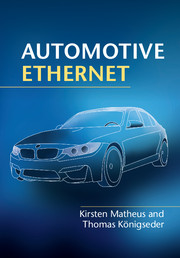Book contents
- Frontmatter
- Contents
- Preface
- Abbreviations
- Timeline
- 1 A brief history of “Ethernet” (from a car manufacturer’s perspective)
- 2 A brief history of in-car networking
- 3 A brief history of Automotive Ethernet
- 4 The physical transmission
- 5 Protocols for Automotive Ethernet
- 6 Ethernet in automotive system development
- 7 Outlook
- Index
- References
4 - The physical transmission
Published online by Cambridge University Press: 05 December 2014
- Frontmatter
- Contents
- Preface
- Abbreviations
- Timeline
- 1 A brief history of “Ethernet” (from a car manufacturer’s perspective)
- 2 A brief history of in-car networking
- 3 A brief history of Automotive Ethernet
- 4 The physical transmission
- 5 Protocols for Automotive Ethernet
- 6 Ethernet in automotive system development
- 7 Outlook
- Index
- References
Summary
To understand physical transmission in in-car networks two aspects are important: the actual automotive environment in which the communication happens and how the properties of the PHY technology ensure its use in this environment. This chapter will therefore start with the PHY technologies in Section 4.1, explain the automotive channel in Section 4.2, and discuss ElectroMagnetic Compatibility (EMC) in Section 4.3. Other important requirements in this context, such as semiconductor quality, Power over Data Line (PoDL), and Energy Efficient Ethernet (EEE), are introduced in Section 4.4.
The Physical Layer (PHY) technology
100 Mbps BroadR-Reach (OABR)
It all started with the IEEE 802.3 1000BASE-T standard. During its development, the engineers at Broadcom learned to handle the communication challenges that needed to be mastered for such a high data rate transmission. So when Ethernet in the First Mile (EFM) was being developed at IEEE, Broadcom reused some of the basic principles of 1000BASE-T for a suitable solution: instead of four pairs of wiring one pair was used and the channel coding was made more robust, so that it was possible to transmit 100 Mbps data over a worse, i.e. longer, channel. IEEE standardized a different solution for EFM, while Broadcom proposed their technology for EFM in China [1]. When BMW was looking for an Ethernet solution suitable for automotive another interesting use case was found for the Broadcom technology.
- Type
- Chapter
- Information
- Automotive Ethernet , pp. 92 - 133Publisher: Cambridge University PressPrint publication year: 2014



